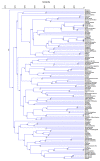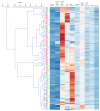Uncovering Olive Biodiversity through Analysis of Floral and Fruiting Biology and Assessment of Genetic Diversity of 120 Italian Cultivars with Minor or Marginal Diffusion
- PMID: 31466369
- PMCID: PMC6783865
- DOI: 10.3390/biology8030062
Uncovering Olive Biodiversity through Analysis of Floral and Fruiting Biology and Assessment of Genetic Diversity of 120 Italian Cultivars with Minor or Marginal Diffusion
Abstract
The primary impetus behind this research was to provide a boost to the characterization of the Italian olive biodiversity by acquiring reliable and homogeneous data over the course of an eight-year trial on the floral and fruiting biology of 120 molecularly analyzed cultivars, most of which have either low or very low diffusion. The obtained data highlighted a considerable variability to almost all of the analyzed parameters, which given the uniformity of environment and crop management was indicative of a large genetic variability in the accessions under observation, as confirmed through the molecular analysis. Several cases of synonymy were reported for the first time, even among plants cultivated in different regions, whilst all of the varieties examined, with only one exception, showed very low percentages of self-fruit-set, indicating a need for the employment of suitable pollinator plants. Eventually, a fitted model allowed us to evaluate the clear effects of the thermal values on blossoming, particularly in the months of March and April, whereas the climatic conditions during the flowering time had only a modest effect on its duration.
Keywords: Olea europaea L.; SSR; flowering; fruiting biology; modelling.
Conflict of interest statement
“The authors declare no conflict of interest.”
Figures









References
-
- Aguilera F., Valenzuela L.R. Microclimatic-induced fluctuations in the flower and pollen production rate of olive trees (Olea europaea L.) Grana. 2012;51:228–239. doi: 10.1080/00173134.2012.659203. - DOI
-
- Lavee S., Rallo L., Rapoport H.F., Troncoso A. The floral biology of the olive, effect of flower number, type and distribution on fruitset. Sci. Hortic. 1996;66:149–158. doi: 10.1016/S0304-4238(96)00941-7. - DOI
-
- Camposeo S., Ferrara G., Palasciano M., Godini A. About the biological behaviour of cv. Coratina. Acta Hortic. 2012;949:129–133. doi: 10.17660/ActaHortic.2012.949.17. - DOI
-
- Farinelli D., Boco M., Tombesi A. Results of four years of observations on self-sterility behaviour of several olive cultivars and significance of cross-pollination; Proceedings of the 2nd International Seminar Olivebioteq; Marsala-Mazara del Vallo, Italy. 5–10 November 2006; pp. 275–282.
LinkOut - more resources
Full Text Sources
Molecular Biology Databases
Miscellaneous

